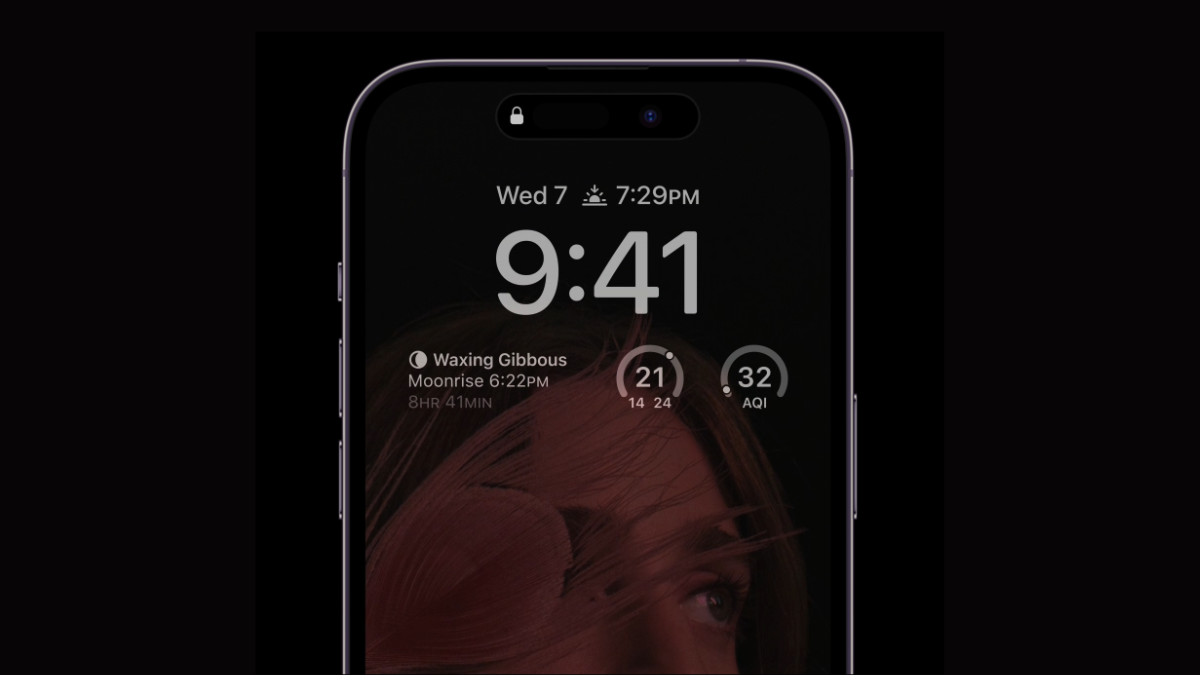For years, Android phones with OLED screens have come with Always On Display, an option that lets users take a glimpse of their phone’s screen to check the time or any pending notifications. Although iPhones have had OLED displays since the launch of the iPhone X, Apple didn’t develop such a feature for its iPhones or any of its devices, until now.
Which iPhones have Always On Display in 2022?
With the introduction of the new iPhone 14 Pro series, Apple has finally added an Always On Display to allow users to take a glance at their phone without needing to tap on it. Yes, even the newly launched iPhone 14 and iPhone 14 Plus do not have the Always On Display feature.
When the feature is enabled, the iPhone 14 Pro and iPhone 14 Pro Max will continue to show a dimmed version of your Lock Screen with the date, time, weather, and information from any other widgets that you may have added to your Lock Screen.
The Always-On display will get activated when you lock your iPhone with the Side button. When your phone is placed face down on a table or inside your pocket, your iPhone won’t show the Always On Display but instead will turn off the screen to save its battery life. Unlike a traditional Always-On Display on Android phones, the information on your Lock Screen will show up on top of your current wallpaper instead of a black screen. The wallpaper will, however, appear darker than usual with its colors faded out to preserve battery.
What does your iPhone need to have Always On Display?
For the Always On Display to work, Apple has used a revamped version of its OLED LTPO ProMotion display whose refresh rates not only go up to 120Hz but can also be lowered to 1Hz. This low refresh rate can help the iPhone 14 Pro devices show a static lock screen with all its elements and widgets without draining much of its battery. This isn’t the first time Apple has introduced an Always On Display as the feature made it first on the Apple Watch Series 7 whose display could also trigger a 1Hz refresh rate.
When the Always On Display option is triggered, the display on the new iPhone 14 Pro models switches to 1Hz, making it ideal for a static display that doesn’t have animations. Since the OLED LTPO 1Hz display is only installed on the iPhone 14 Pro and iPhone 14 Pro Max, these are the only two devices to equip an Always On Display. This means the iPhone 14 and iPhone 14 Plus won’t feature Always On Display since they don’t come installed with the same display technology.
Do iPhone 13, 12, or 11 have Always On Display?
No. Always On Display is a new feature that has only been introduced with the iPhone 14 Pro and iPhone 14 Pro Max. Although the iPhone 13, iPhone 12, and some models of iPhone 11 have OLED displays, there’s currently no option that triggers Always On Display on any of these devices.
Will iPhone 13, 12, or 11 get Always On Display later?
Apple’s Always On display is different from that available on Android devices. Instead of turning the entire screen black, the company has opted to dim the Lock Screen background when its Always On mode is enabled. To achieve such an effect, your iPhone needs to have Apple’s ProMotion display that adapts to different refresh rates, especially lower values so that it can be power efficient.
Since all iPhones older than the iPhone 13 Pro lack a ProMotion display, we can rule out the iPhone 13, iPhone 13 mini, iPhone 12, and iPhone 11 to get Always On Displays in the future. Among older devices, only the iPhone 13 Pro and iPhone 13 Pro Max feature ProMotion displays that can go as low as 10Hz in refresh rate.
Although a 10Hz display would consume more energy than a 1Hz display, the difference wouldn’t be drastic. This means the iPhone 13 Pro and iPhone 13 Pro Max have the highest likelihood of getting the Always On Display feature in the future. Whether Apple decides to bring it to these devices or not only time will tell.
That’s all you need to know about Always On Display on iPhone 13, iPhone 12, and iPhone 11.













Discussion